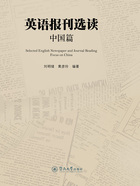
Unit One Economy
Ⅰ.Background Information
1.Market Economy
A market economy is an economy in which decisions regarding investment,production and distribution are based on supply and demand,and the prices of goods and services are determined in a free price system.This is contrasted with a planned economy,where investment and production decisions are embodied in a plan of production.Market economies can range from hypothetical laissez-faire and free market variants to regulated markets and interventionist variants.Most existing market economies include a degree of economic planning or state-directed activity,and are thus classified as mixed economies.
In the real world,market economies do not exist in pure form,as societies and governments regulate them to varying degrees rather than allow full self-regulation by market forces.The term free-market economy is sometimes used synonymously with market economy.However,as Ludwig Erhard once pointed out,this does not preclude an economy from providing various social welfare programs such as unemployment benefits,as in the case of the social market economy.
2.Stock Market
A stock market is a public market for the trading of company stock and derivatives at an agreed price;these are securities listed on a stock exchange as well as those only traded privately.The stocks are listed and traded on stock exchanges which are entities of corporations or mutual organizations specialized in the business of bringing buyers and sellers of the organizations to a listing of stocks and securities together.The stock market in the United States includes the trading of all securities listed on the NYSE Euronext(纽约—泛欧交易所),the NASDAQ(全美证券交易商协会自动报价系统),the AMEX(美国证券交易所),as well as on the many regional exchanges,e.g.OTCBB(场外柜台交易系统) and Pink Sheets(粉纸市场,也称粉单市场).European examples of stock exchanges
include the London Stock Exchange(伦敦证券交易所) and the Deutsche (德意志证券交易所).Participants in the stock market range from small individual stock investors to large hedge fund traders,who can be based anywhere.Their orders usually end up with a professional at a stock exchange,who executes the order.
(德意志证券交易所).Participants in the stock market range from small individual stock investors to large hedge fund traders,who can be based anywhere.Their orders usually end up with a professional at a stock exchange,who executes the order.
The stock market is one of the most important sources for companies to raise money.This allows businesses to be publicly traded,or raise additional capital for expansion by selling shares of ownership of the company in a public market.The liquidity that an exchange provides affords investors the ability to quickly and easily sell securities.This is an attractive feature of investing in stocks,compared to other less liquid investments such as real estate.
3.The Shanghai Stock Exchange (上海证券交易所)
The Shanghai Stock Exchange(SSE) is a stock exchange that is based in the city of Shanghai,China.It is one of the two stock exchanges operating independently in mainland China,and the other is the Shenzhen Stock Exchange.The Shanghai Stock Exchange is the world's 6th largest stock market by market capitalization at U.S.$2.3 trillion as of December,2011.Unlike the Hong Kong Stock Exchange,the Shanghai Stock Exchange is still not entirely opened to foreign investors due to the tight capital account controls exercised by the Chinese mainland authorities.
The current exchange was re-established on November 26,1990 and was in operation on December 19 of the same year.It is a non-profit organization directly administered by the China Securities Regulatory Commission (CSRC).
4.The Shenzhen Stock Exchange (深圳证券交易所)
The Shenzhen Stock Exchange (SZSE) is one of the three stock exchanges in the People's Republic of China,alongside the Shanghai Stock Exchange and the Hong Kong Stock Exchange.It is based in Shenzhen,China.The market capitalization of its listed companies was about U.S.$1 trillion in 2011.
5.Renminbi
TheRenminbi(abbreviation:RMB;sign:¥;code:CNY) istheofficialcurrency of thePeople'sRepublicofChina.Theyuan isthebasicunitoftheRenminbi,butisalso used to referto theChinesecurrency generally,especially in internationalcontexts.TheISO4217 standard codeforRenminbiisCNY,an abbreviation for“Chineseyuan”.Thedistinction between theterms“Renminbi” and “yuan” issimilarto thatbetween sterling and pound,which respectively referto theBritish currency and itsprimary unit.Thename(simplified Chinese:人民币) literally means“people'scurrency”.
Oneyuan issubdivided into 10 jiao (角),and onejiao in turn issubdivided into 10 fen (分).Renminbibanknotesareavailablein denominationsfrom1 jiao to 100 yuan (¥ 0.1-¥ 100) and coinshavedenominationsfrom 1 fen to 1 yuan (¥ 0.01-¥ 1).Thussome denominationsexistin both coinsand banknotes.Coinsunder¥ 0.1 areused infrequently.
6.Chinese Economic Reform
The Chinese economic reform refers to the program of economic reforms called "Socialism with Chinese characteristics" in the People's Republic of China that was started in December,1978 by reformists within the Communist Party of China led by Deng Xiaoping.
China was one of the world's largest and most advanced economies prior to the 19th century,while national product per capita remained average in global terms.The economy had stagnated since the 16th century,and even declined in absolute terms in the 19th and much of the 20th century,only with a brief recovery in the 1930s.
Economic reforms introducing market principles began in 1978 and were carried out in two stages.The first stage,in the late 1970s and early 1980s,involved the de-collectivization of agriculture,the opening up of the country to foreign investment,and the permission for entrepreneurs to start-up businesses.However,most industry remained state-owned.The second stage,in the late 1980s and 1990s,involved the privatization and contracting out of much state-owned industry and the lifting of price controls,protectionist policies,and regulations,although state monopolies in sectors such as banking and petroleum remained.The private sector grew remarkably,accounting for as much as 70%of China's GDP by 2005.From 1978 to 2013,unprecedented growth occurred,with the economy increasing by 9.5%per year.China's economy surpassed that of Japan in 2010 as Asia's largest economy and became the second largest after the United States and is projected to become the world's largest economy by 2029.